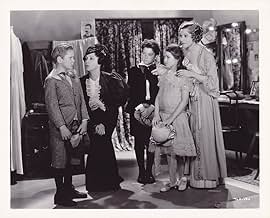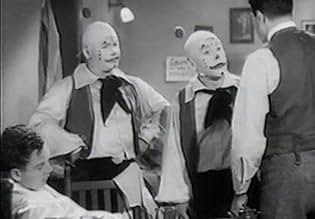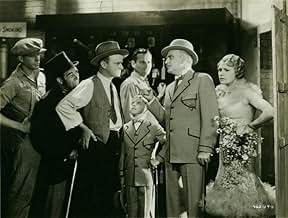Adicionar um enredo no seu idiomaA vaudeville couple quit to raise a son, then come back with their grandson in the act.A vaudeville couple quit to raise a son, then come back with their grandson in the act.A vaudeville couple quit to raise a son, then come back with their grandson in the act.
- Direção
- Roteiristas
- Artistas
- Prêmios
- 3 vitórias no total
- Dancing Ensemble - Edited from The March of Time (1930)
- (cenas de arquivo)
- (as Albertina Rasch Dancers)
- Cousin David
- (não creditado)
- Man in Balcony
- (não creditado)
- Joe Mannion
- (não creditado)
- Wanda
- (não creditado)
- William Collier Sr. - Vaudeville Act
- (cenas de arquivo)
- (não creditado)
- Self
- (cenas de arquivo)
- (não creditado)
- Aunt Clara
- (não creditado)
- Direção
- Roteiristas
- Elenco e equipe completos
- Produção, bilheteria e muito mais no IMDbPro
Avaliações em destaque
I have a few final comments that I hope provoke your interest and might make the film, despite its limitations, worth watching. It's interesting that Jackie Cooper received third billing in this film--although he's in the film only about five minutes or so! This is undoubtedly because, at the time, he was a HUGE star at MGM, but I am sure his fans were disappointed in seeing so little of him in the movie. Also, right after Junior's wife dies, watch for a scene with two bizarre clowns. It's practically impossible to tell because of all the makeup, but these are Curly and Moe Howard of the Three Stooges! This is because the Stooges originally signed with MGM but the studio had no idea what to do with them--and stuck them in some very strange films (including some very odd roles in "Dancing Lady"). Finally, watch the very young Mickey Rooney tap dancing (in the scene right after the Stooges). He is simply amazing to watch--especially because this performing dynamo was so young! Wow--what talent.
Alice Brady and Frank Morgan play Ted and Lulu Hackett, vaudeville performers who want their name to be known for generations, which it indeed does, but not in the way they expected as their son, Ted Jr., travels to broadway and later Ted Jr.'s son, Ted III goes to make pictures in Hollywood. Alice Brady and Frank Morgan do a good job as the stars with the most screen time but their husband/wife bickering can get boring after a while.
Many of the stars who received top billing in the film, (Jackie Cooper, Mickey Rooney, Jimmy Durante, etc.) only appear in the film for a couple minutes so you would have to be a huge fan to sit through the whole film just to see them. Another interesting cameo is in the middle of the film when two freaky-looking Dutch clowns appear with Ted Hackett Jr. (played by Russell Hardie). I didn't realize this the first time I watched it, but the two clowns are actually played by brothers Moe and Curly Howard of the Three Stooges. As a longtime fan of the trio, this alone was a reason to buy the film and give it another watch.
Besides the ending of it being a little out of place, I enjoyed most of the film throughout. It isn't the most entertaining flick ever made, but I definitely suggest seeing it when you get the chance.
There is a bit of obvious pre-code Hollywood at times, which time stamps the movie, and so many cast members became Hollywood legends. And offense taken by Buster Keaton is notable off-screen insight.
So, it depends on the lens you look through. The long-shot lens of this time capsule shows some tragedy, closeups show some comedy, as Chaplin once said about film making.
I enjoyed this. Frank Morgan, Mickey Rooney, Alice Brady, Jimmie Durante, Curly and Moe Howard, Jackie Cooper... footage from an unreleased musical that otherwise wouldn't have any use... so many careers and so much information floated the boat for what otherwise may have been a creaky ship of viewing.
I was entertained on several levels.
The first tale is why this film was made in the first place. In late 1930 MGM producer Harry Rapf was making a sequel to the Hollywood Revue of 1929. Unfortunately, musicals went out of fashion before the movie was finished and MGM had to shelve the project. Thus MGM was saddled with some very expensive musical footage and no movie. This film was an attempt to try to fit a story around some of that footage and recoup some of the losses. That is why you'll find long and often elaborate production numbers that don't really fit the plot placed awkwardly at points along the movie.
The second tale of interest is how this movie was considered by Buster Keaton to be "the final insult" hurled at him by MGM after they unceremoniously fired him this same year - 1933. He thought that the story of the third generation of Hacketts - Ted Hackett III - looked just a little too autobiographical to be a coincidence. Ted the 3rd is the member of a famed vaudeville family who gets recruited to go into motion pictures. Once he gets to Hollywood he begins to drink heavily - a vice that his father also had - and his drinking causes him to be late to the movie set if he even bothers to show up at all. Buster was furious about this movie, and nobody could convince him his own problems with MGM were not at the foundation of the plot and that it was simply an attempt to salvage "The March of Time" alias The Hollywood Revue of 1930.
Take these points of interest away from the film and there really is not much to see here other than Morgan and Brady's excellent performance as the senior generation of Hacketts who see "the march of time" from the height of vaudeville's popularity through the arrival of talking pictures which renders their profession obsolete.
The problem for a contemporary viewer is that the people in cameos and the names that are dropped are probably unknown to the MTV generation. You would have to know that Joe Weber and Lew Fields for instance were a great vaudeville comedy team who then went into the producing end of the business in order to appreciate a scene where Joe Weber wants to hire young Ted Hackett II, and will give the elder Hacketts small bits in his show in order to get him.
Because it is revived every year around the 4th of July, I suppose Yankee Doodle Dandy is the best comparison to this film to make. The elder Cohans there are a show business family whose kids are raised in the theater atmosphere the way the Hacketts raise their son. Of course here we go into a third generation of Hacketts.
Doing a small unbilled part in this film is Nelson Eddy who sings In the Garden of My Heart during a show. Ironically in two years Eddy would be starring in Naughty Marietta and Frank Morgan would be supporting him.
In reading the credits I was flabbergasted to read that the brothers Howard of the 3 Stooges played a pair of clowns who essentially roll a drunken Ted Hackett Jr. as he's being fired from a show. Certainly Moe and Curly who started in vaudeville would know all about that venue of show business. They are unrecognizable in their clown make up.
When the film is nearing it's conclusion it's now Ted Hackett III who is hitting the big time in Hollywood played by Eddie Quillan. His parents were played by Russell Hardie and Madge Evans. Still it's Morgan and Brady who carry this. It's like if Walter Huston and Rosemary DeCamp were the central characters of Yankee Doodle Dandy.
It's a nice film with a good story, but I fear it's too dated for today's audience.
Você sabia?
- CuriosidadesNelson Eddy - 33 at the time - was required to do a screen test for the film). Eddy's test took 58 takes and even the best was determined to be awful. MGM studio head Louis B. Mayer overruled everyone and ordered that he be only used for a singing sequence in the film.
- Citações
Lulu Hackett: Actors haven't any more rights than other people. Anyway, I ain't crazy over actors.
Ted Hackett: Aww, don't say that, mama. It's a grand old profession.
Lulu Hackett: Yeah, I don't know about that. We're like monkeys climbing up and hanging by our tails, and the people outside the cages laugh and think it's funny. Yeah. Well, that's all right, so long as we don't quit amusing them.
Ted Hackett: Yeah, but we never quit. That's something performers don't do. They go on and on. They die, mother, but they don't quit.
- Cenas durante ou pós-créditosIntro: "New York in the late 80's. Its great variety hall and most popular place of entertainment - - Tony Pastor's Theatre - where the greatest celebrities known to the amusement world started their careers. Upon its historical old stage this story begins."
- ConexõesEdited from The March of Time (1930)
Principais escolhas
- How long is Broadway to Hollywood?Fornecido pela Alexa
Detalhes
- Data de lançamento
- País de origem
- Idioma
- Também conhecido como
- Broadway to Hollywood
- Locações de filme
- Empresa de produção
- Consulte mais créditos da empresa na IMDbPro
- Tempo de duração1 hora 25 minutos
- Cor
- Proporção
- 1.37 : 1
Contribua para esta página



































